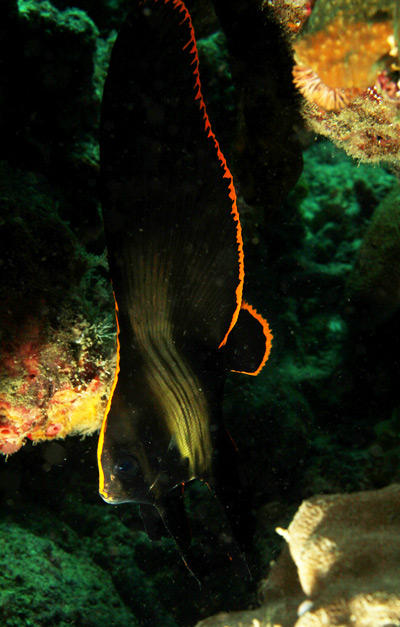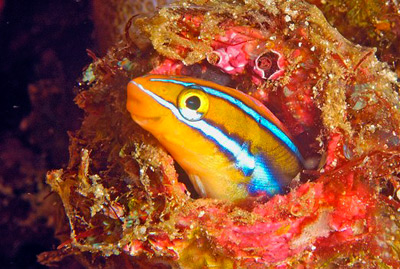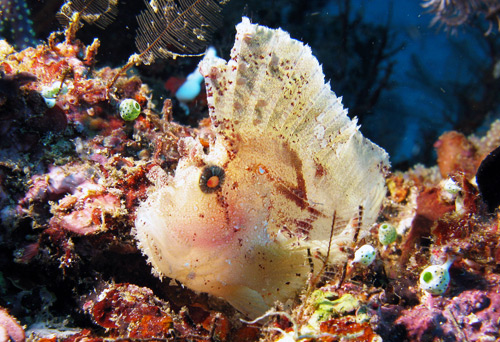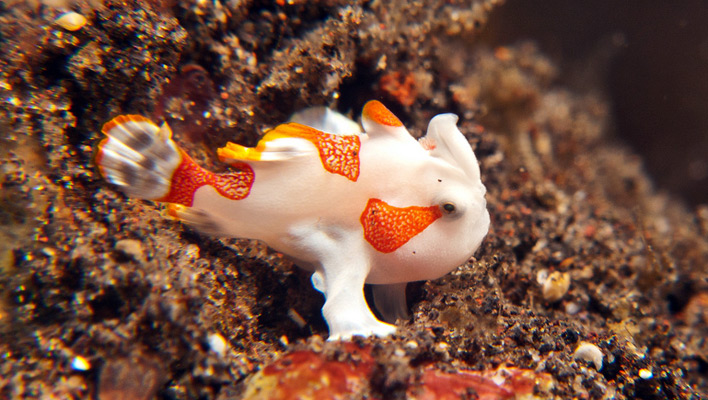In the fish-eat-fish world of the coral reefs, it can sometimes be beneficial to look like something you’re not. This strategy, known as mimicry, is employed by a wide variety of marine fish and other organisms in order to garner some sort of survival edge. Not only is mimicry exhibited by numerous fish species, but it also takes on many different, fascinating forms, such as:
- A harmless or helpless fish imitating a dangerous or distasteful organism
- A predatory or otherwise dangerous fish imitating a harmless one
- Using ingenious camouflage to deceive predators or prey items
Let’s explore some of these mimicry styles a little further with some examples of species that put them into practice.
That’s right, I’m bad!
On the coral reefs, there are many examples of innocuous marine fish pretending to be much more nasty or noxious than they really are. Take the saddled filefish (Paraluteres prionurus) for instance. This fielfish is almost identical in body shape, coloration, and patterning to the saddled toby (Canthigaster valentini), a puffer species that contains deadly tetrodotoxin in its tissues. Wary predators are apt to leave it alone despite the fact that it’s actually edible.
 Juvenile pinnate batfish (Platax pinnatus) provide another great example of this form of mimicry. Quite different in appearance from the adults, these little guys are solid black overall with a red margin around the entire outline of the fish—coloration very similar to that of certain toxic or foul-tasting polyclad flatworms.
Juvenile pinnate batfish (Platax pinnatus) provide another great example of this form of mimicry. Quite different in appearance from the adults, these little guys are solid black overall with a red margin around the entire outline of the fish—coloration very similar to that of certain toxic or foul-tasting polyclad flatworms.
Yet another interesting case in point is the comet, or marine betta (Calloplesiops altivelis). This species has often been observed concealing its head in a reef crevice, leaving the posterior portion of its body—which is dark brown with white polka dots and a prominent eyespot—visible. A would-be predator could be forgiven for mistaking this portion of the comet for the head of a whitemouth moray eel (Gymnothorax meleagris).
The wolf in sheep’s clothing
 One of the better known examples of this type of mimicry is that exhibited by the bluestriped fangblenny (Plagiotremus rhinorhynchos). This streamlined species, which feeds on the skin, mucus, and scales of other fish, is capable of changing its color to closely match that of the bluestreak cleaner wrasse (Labroides dimidiatus). Fishes duped into trusting this faux cleaner to rid them of ectoparasites get nipped for their trouble.
One of the better known examples of this type of mimicry is that exhibited by the bluestriped fangblenny (Plagiotremus rhinorhynchos). This streamlined species, which feeds on the skin, mucus, and scales of other fish, is capable of changing its color to closely match that of the bluestreak cleaner wrasse (Labroides dimidiatus). Fishes duped into trusting this faux cleaner to rid them of ectoparasites get nipped for their trouble.
Nothing to see here!
Camouflage that convinces would-be predators or prey items that the fish is just part of the background is another common form of mimicry seen on the coral reefs. While many species use camouflage to one degree or another, some elevate it to a true art form.
The so-called ghost pipefishes (family Solenostomidae), for example, blend in so expertly with various sessile invertebrates, macroalgae, and seagrasses that they can be difficult for even the most discerning observer to spot. Some are so convincingly camouflaged that they make terrestrial stick insects look like amateurs!
Similarly, many of the scorpaenids (scorpionfishes and stonefishes) and antennariids (frogfishes/anglerfishes) readily “hide in plain sight,” owing to natural growths and cryptic coloration that allow them to blend in seamlessly with substrates on and around the coral reefs. Fishes failing to discern their outline and blundering too close are gulped down with lightening speed. Some scorpaenid species, such as the notorious Synanceia verrucosa and S. horrida, have a highly venomous sting and can even cause human fatalities. Definitely not good choices for the home aquarium!
 The various frogfishes take camouflage to even greater heights than the scorpaenids. In addition to exhibiting highly cryptic coloration and warty/frilly growths that help them “disappear” against various substrates and sessile invertebrates, they use a modified dorsal spine tipped with a fleshy bait to lure prey items into gulping range—like strange little fisherfolk casting a line.
The various frogfishes take camouflage to even greater heights than the scorpaenids. In addition to exhibiting highly cryptic coloration and warty/frilly growths that help them “disappear” against various substrates and sessile invertebrates, they use a modified dorsal spine tipped with a fleshy bait to lure prey items into gulping range—like strange little fisherfolk casting a line.
What mimic interests you most?
Of course, this is only a sampling of the marine fishes that practice some form of mimicry. If you have another example that interests you, please feel free to share it with your fellow salties in the comment section below.




I recently went on trip to Hawaii, specifically Lanai, Kawii and Maui. The visibility there underwater is not very good at all but I took quite a few pictures underwater. Sole’s are fairly common as are frogfish but almost impossible to see even when someone points one out and practically puts their finger right on the fish as they blend in so well. Lizzardfish are also common and just as hard to see except that they hang out on the sand so that may give away their position. Small rays partially bury themselves in the sand and you only see them when they move. Oddly enough some very large sea urchins are bright red, I can’t figure out why they evolved that particular color as they are found in very shallow water and real easy to see. But the fish that spent their time at the surface like needlefish are bright silver and can’t be seen from below by potential predators.
Blennies are cuties even when they’re trying to take a piece out of your finger it seems.
A bit off topic, but what are the small green orbs growing about the rock in the last pic? Some sort of sponge maybe? I’d much like my rock to sprout some of those, they’re quite neat.
Hi Kevin! Chris and I are fairly certain those orbs are a type of tunicate (sea squirt), possibly Atriolum robustum or a similar species. Unfortunately, aquariums usually don’t provide adequate quantities of the miniscule planktonic food items these filter feeders require, so most starve to death in captivity.
Awesome fishes here but the mimic octopus could give them a good run for their money ;D
No question, Grant! Great point! In fact, we may have to dedicate a future post to the mimic octopus–truly an unparalleled master of disguise.
Indeed, Grant! If you’re an octopus fan, you’ll get a kick out of this post: http://bit.ly/1bM01O0